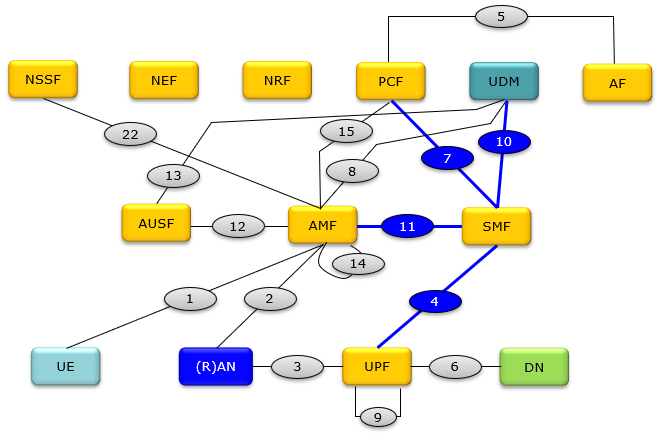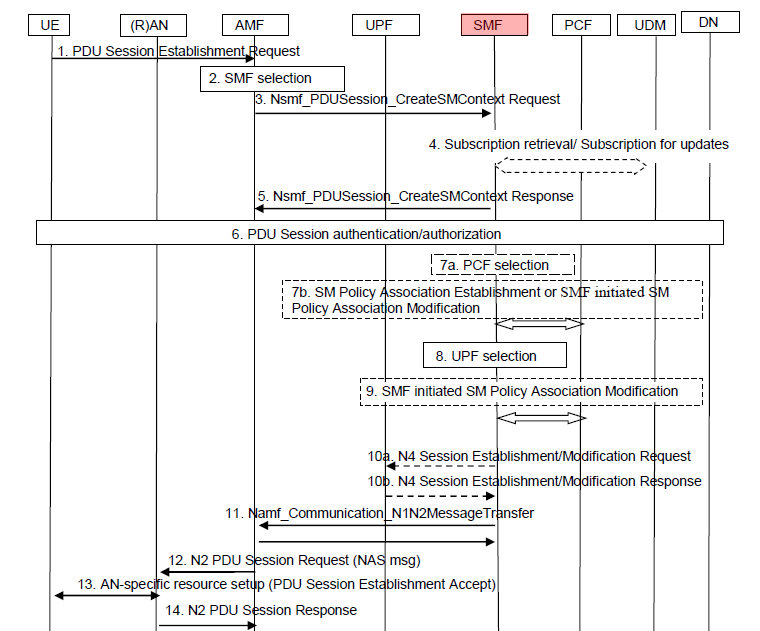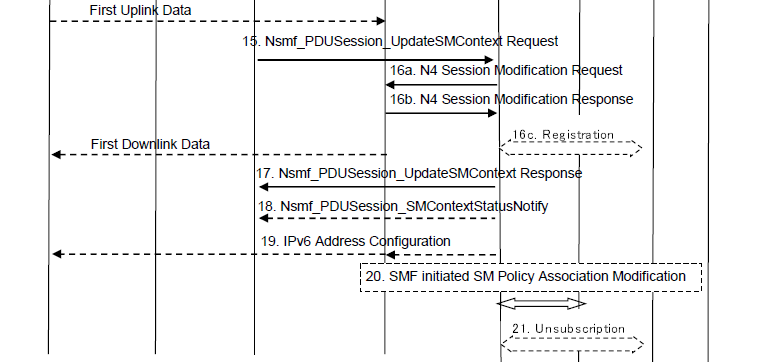|
NR CORE - SMF
SMF stands for Session Management Function. Simply put, it collects all the informations related to PDU session management from various network components (e.g, UPF, PCF, UDM) and controls / orchastrates those network components based on request from AMF.
The SMF and interactions with other network components within 5G Core network is illustrated below.

Followings are the name of each network component.
AMF Access and Mobility Management Function ==> Equivalent to MME in 4G
AUSF Authentication Server Function
DN Data Network
NEF Network Exposure Function
NRF Network Repository Function
NSSF Network Slice Selection Function
PCF Policy Control Function ==> Equivalent to PCRF in 5G
(R)AN (Radio) Access Network
SMF Session Management Function
UDM Unified Data Management ==> Equivalent to HSS in 4G
UPF User Plane Function ==> Equivalent to PGW in 4G
SMSF SMS Function
SEAF SEcurity Anchor Function ==> part of AMF function
ARPF Authentication credential Repository and Processing Function
SIDF Subscription Identifier De-concealing Function
Based on 23.501-6.2.2, the functionality of AMF is descrbed as follows. The most fundamental function of SMF is PDU session management and you can take all other functions as subsidiary functions to better manage PDU session.
- PDU Session Establishement (23.502-4.3.2) : The SMF is responsible for establishing, modifying, and releasing PDU sessions. These sessions are logical connections between the UE and the Data Network (DN).
- a UE initiated PDU Session Establishment procedure.
- a UE initiated PDU Session handover between 3GPP and non-3GPP.
- a UE initiated PDU Session handover from EPS to 5GS.
- a Network triggered PDU Session Establishment procedure.
- IP Address Management : It allocates and manages IP addresses for UEs, handling both IPv4 and IPv6 address types. It performs the role of a DHCP server for IP address allocation
- QoS Management : It configures traffic steering parameters and ensures appropriate routing of packets in the UPF
- Policy Control : The SMF interacts with the Policy Control Function (PCF) to receive and implement policy and charging rules
- Charging : The SMF handles connectivity charging through interaction with the Charging Function (CHF)
- Downlink Data Notification : The SMF manages the process of notifying the network when downlink data arrives for an idle UE, initiating paging procedures
- Subscription Verification : It checks UE requests against user subscriptions to ensure compliance
- Traffic usage reporting : The SMF interacts with the User Plane Function (UPF) to collect usage data for each PDU session.
- Packet routing and forwarding : SMF configures the UPF with the necessary routing and forwarding rules for each PDU session. It instructs the UPF on how to handle incoming and outgoing packets for specific sessions.
- Traffic steering : The SMF receives policy rules from the PCF that may include traffic steering instructions. Based on these rules, the SMF configures the UPF to apply appropriate traffic steering policies. It can instruct the UPF to route traffic through specific network slices or to particular data networks based on service requirements.
At its core, the SMF is the orchestrator of user sessions. Think of it as the "brain" behind each user's connection to the 5G network. It doesn't just establish and terminate sessions; it dynamically manages them throughout their lifecycle. This includes handling mobility, Quality of Service (QoS) changes, and even applying policy updates in real-time.
SMF interacts with various other components as follows.
AMF (Access and Mobility Management Function) - Interface N11: This is a critical interaction for session establishment and control. The AMF is responsible for managing the initial connection between the user equipment (UE) and the 5G core network. When a user wants to access data services, the AMF triggers the SMF via the N11 interface to:
- Create a new PDU session: The AMF provides the SMF with information about the user and the requested services, allowing the SMF to establish a dedicated PDU session for the user's data traffic.
- Modify an existing session: If the user's QoS requirements or network conditions change, the AMF can request the SMF to modify the existing session parameters, ensuring optimal performance.
- Terminate a session: When the user disconnects or their session expires, the AMF informs the SMF to release the allocated resources and terminate the PDU session.
- This dynamic interaction between the AMF and SMF ensures that user sessions are efficiently managed throughout their lifecycle, from initial attachment to final detachment.
UDM (Unified Data Management) - Interface N10: This interaction is crucial for the SMF to understand the user it's dealing with. Imagine a user trying to connect to the network. The SMF needs to know:
- Is this user authorized? (Authentication credentials from UDM)
- What services are they subscribed to? (Subscription data from UDM)
- What are their specific data plan limitations? (Data volume, speed caps from UDM)
- Are there any roaming agreements in place? (Roaming information from UDM)
- This information allows the SMF to create a tailored session for the user, ensuring they get the service they expect.
UPF (User Plane Function) - Interface N4: This is where the "rubber meets the road" in terms of data flow. The SMF instructs the UPF on how to handle the user's data packets. Think of the UPF as a sophisticated traffic manager on the highway (the data network). The SMF provides the UPF with instructions like:
- Route this user's traffic through a specific path. (e.g., for optimized gaming performance)
- Apply this QoS policy to prioritize their video streaming. (e.g., ensuring smooth video calls)
- Enforce data usage limits according to their plan.
- Filter certain types of traffic. (e.g., for parental controls)
- The SMF dynamically adjusts these instructions as needed, based on changing network conditions, user mobility, or policy updates.
PCF (Policy Control Function) - Interface N7: The PCF is the policy decision-maker. It provides the rules that the SMF enforces. This interaction is essential for:
- Dynamic QoS adjustments: Imagine a user moving from a Wi-Fi network to a congested 5G cell. The PCF can detect this and instruct the SMF to adjust the QoS parameters, ensuring a seamless experience.
- Charging and billing: The PCF can track data usage and apply the appropriate charging rules based on the user's plan.
- Network slicing: The PCF can assign users to specific network slices with tailored performance characteristics (e.g., low latency for critical IoT devices).
- Security policy enforcement: The PCF can define security policies, and the SMF ensures they are applied to the user's session.
The UE-Initiated PDU Session Establishment process in the 5G Core (5GC) network is a fundamental procedure that allows a User Equipment (UE) to establish a Packet Data Unit (PDU) session with the network. This process is essential for the UE to gain access to data services in the 5G network.
The UE-Initiated PDU Session Establishment process in the 5G Core network is a multi-step procedure that involves several network functions working in tandem to set up a data session for the UE. This process ensures that the UE gets the necessary resources and policy treatment for its data traffic.
The high level description on the interaction between SMF and other network components for the PDU session establishment can be described as follows :
- PDU Session Establishment Request: The process begins when the UE sends a PDU Session Establishment Request to the Access and Mobility Management Function (AMF). This request contains necessary information such as the desired Slice/Service Type (SST), Session and Service Continuity (SSC) mode, and other relevant parameters.
- AMF to SMF Request: The AMF forwards the request to the Session Management Function (SMF). The AMF selects an SMF based on the information provided by the UE and other network policies.
- SMF Interaction with UPF: The SMF interacts with the User Plane Function (UPF) to set up the necessary user plane resources. The UPF is responsible for handling user data traffic and routing it appropriately.
- Policy Control: The SMF may also interact with the Policy Control Function (PCF) to obtain policy rules for the new PDU session. These rules dictate how the user's data should be treated (e.g., Quality of Service, charging, etc.).
- PDU Session Establishment Accept: Once the necessary resources are allocated and policy rules are set, the SMF informs the AMF, which in turn sends a PDU Session Establishment Accept message to the UE.
- Data Transfer: With the PDU session established, the UE can now transfer data with the 5G network. The UPF handles the routing of this data to the appropriate destination, be it the internet, another UE, or a service within the 5G network.
- Session Context: Throughout the session, the SMF maintains the session context, which contains all the necessary information about the PDU session, such as the allocated resources, policy rules, and other session parameters.
The detailed signaling procedure for PDU session Establishement is depicted in 3GPP as follows :
< 23.502 - Figure 4.3.2.2.1-1: UE-requested PDU Session Establishment for non-roaming and roaming with local breakout >


1. PDU Session Establishment Request: The User Equipment (UE) initiates a request to establish a PDU session by sending the message to AMF. This is the initial communication signaling the UE's intent to establish a data session.
2. SMF selection: The AMF (Access and Mobility Management Function) selects an appropriate SMF (Session Management Function) for managing this PDU session.
3. Nsmf_PDUSession_CreateSMContext Request: AMF sends a request to the selected SMF to create a session management context. This context holds information about the session.
4. Subscription retrieval/ Subscription for updates: SMF interacts with the UDM (Unified Data Management) to retrieve subscription details or subscribe for updates. This ensures SMF has the latest subscriber information.
5. Nsmf_PDUSession_CreateSMContext Response: The SMF responds to the AMF indicating the result of the session management context creation, either successful or with reasons for failure.
6. PDU Session authentication/authorization: Before proceeding, there's an authentication and authorization process ensuring the UE has the right permissions to establish the session.
7a. PCF selection: The SMF selects a PCF (Policy Control Function) for policy decisions related to this session.
7b. SM Policy Association Establishment or SMF initiated SM Policy Association Modification: This step involves either establishing a new policy association or modifying an existing one based on the session requirements.
8. UPF selection: The SMF selects a UPF (User Plane Function) which will handle the user plane traffic for this session.
9. SMF initiated SM Policy Association Modification: The SMF might initiate a modification to the established policy association based on certain criteria or network conditions.
10a. N4 Session Establishment/Modification Request: SMF make a request to UPF to establish or modify a session on the N4 interface, which is between the SMF and UPF.
10b. N4 Session Establishment/Modification Response: The UPF responds to the SMF's request indicating the success or failure of the session establishment or modification on the N4 interface.
11. Namf_Communication_N1N2MessageTransfer: SMF sends a message to AMF via the Namf_Communication_N1N2MessageTransfer interface. This message contains a wealth of information regarding the PDU session:
12. N2 PDU Session Request (NAS msg): This step involves the AMF sending a PDU session request to RAN over the N2 interface, which is an NAS (Non-Access Stratum) message.
13. AN-specific resource setup (PDU Session Establishment Accept): The Access Network (AN) sets up specific resources for the session, and then a PDU Session Establishment Accept message is sent.
14. N2 PDU Session Response: Finally, a response for the N2 PDU session request is sent from RAN to AMF, indicating the result of the session establishment attempt.
Reference :
YouTube
|


